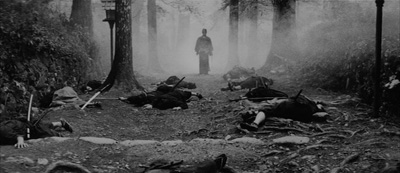A part of this viewing list: Criterion Collection Spine #280: Kihachi Okamoto’s The Sword of Doom.

As I watched this, I kept thinking that if Samuel Fuller had been Japanese, he would have made The Sword of Doom. This film has the curious mix of shlock and art, brutality and grace that Fuller was known for. Even the mechanics of the schlock and art are parallel. The shlock centers around the action and plot, while the art comes through in shot selection and editing. Even the conclusion is Fulleresque, when the shlock gets leveraged into an ambiguous question aimed at the audience. I’m going to need to rewatch Shock Corridor soon, so I can stitch it back to Okamoto’s film.
The Sword of Doom, once again like Shock Corridor, is an examination of the human psyche. The main character, Ryonosuke, is a master swordsman, completely unreadable in regard to fencing style and emotion. He kills for pleasure or power, his exact reasoning is unknown, but the enemies he creates, both known and unknown, follow him seeking revenge. As do the dead. He ends up supporting the ex-wife of one of his victims and sells himself out to groups of ronin as backup for assassination after assassination. If I was a bit more knowledgeable about Japanese history as it concerns the fall of the Tokugawa shogunate I’d probably be able to place a bit more context to his actions. I might be missing a whole layer of applicability here.
Ryonosuke kills his way through a few more years, including killing the woman he supported and her child. He is bent on killing the brother of the woman he killed’s husband whom he killed. Brother is just as intent on killing Ryonosuke, at the behest of Ryonosuke’s late father. At least there is some parity here. Everyone wants Ryonosuke dead, and Ryonosuke wants to kill everyone. Meanwhile, the grand-daughter of a man that Ryonosuke killed is stuck in geisha-training and a thief that Ryonosuke almost killed who has supported the grand-daughter of the man that Ryonosuke killed is trying to free her. They end up coming into contact with the brother of the dead husband with the dead wife and dead child that Ryonosuke killed. Ryonosuke ends up with the grand-daughter of the [oh, fuck it] in a room where he has just been asked to kill the right-hand man of the boss he serves.
The possibility of more death finally catches up with him and Ryonosuke is driven mad by the shades of those he has killed. He tries to kill them again, but the ronin with whom he is currently associated try to kill him in order to stop the madness. Of course, he kills most of them. The film ends during this battle, so likely, no one gets their vengeance.
The fencing did not impress me. I could be a badass samurai judging by the quality of Ryonosuke’s opponents. Most of them just run past him with their katana held high. They don’t even try to hit him. It is like chopping bamboo. Yet the focus on Ryonosuke’s general emotionless aspect as it grows throughout the film and the battle with the shades [pun oh so very intended] are genius scenes. The shade fight is on par with the house of mirrors from The Lady of Shanghai in terms of cinematic artistry. There are a couple hundred other dead samurai in this film [some of which you can see below] but I doubt you want to hear about them. Samurai must have grown on trees during the shogunate. This is a samurai movie that definitely grows on you. Track it down if you like samurai flicks and haven’t seen this one.

• Criterion Essay by Geoffrey O’Brien
• A teaser for the film. I apologize for the classic rock accompaniment to this, but at least there are a few clips of the climactic wig out.
• Bad as the fight scenes were, they are Oscar-winning performances compared to this. [I have since learned that the bad guy in this film is Akron’s own Don Niam.]